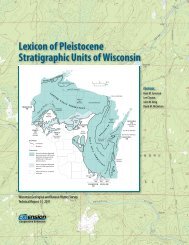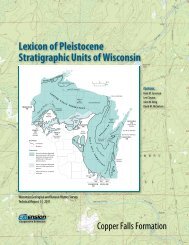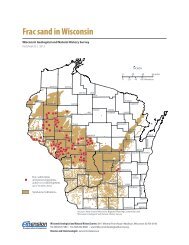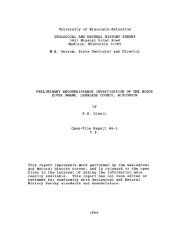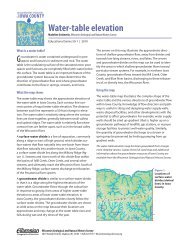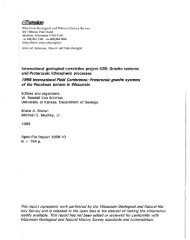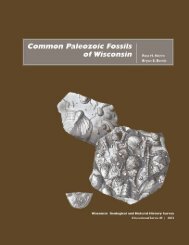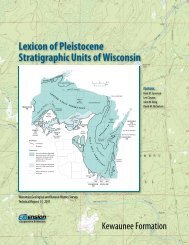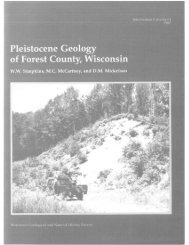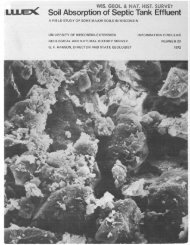middle inlet molybdenite prospect - Wisconsin Geological and ...
middle inlet molybdenite prospect - Wisconsin Geological and ...
middle inlet molybdenite prospect - Wisconsin Geological and ...
Create successful ePaper yourself
Turn your PDF publications into a flip-book with our unique Google optimized e-Paper software.
University of <strong>Wisconsin</strong>-Extension<br />
GEOLOGICAL AND NATURAL HISTORY SURVEY<br />
3817 Mineral Point Road<br />
Madison, <strong>Wisconsin</strong> 53705<br />
M. E. Ostrom, State Geologist <strong>and</strong> Director,<br />
MIDDLE INLET MOLYBDENITE PROSPECT<br />
by<br />
R C Emmons<br />
Open-File Report 43-1<br />
3 p..<br />
This report represents work performed by the <strong>Geological</strong> <strong>and</strong><br />
Natural History Survey, <strong>and</strong> is released to the open files in the<br />
interest of making the information more readily available,. This<br />
report has not been edited or reviewed for conformity with<br />
<strong>Geological</strong> <strong>and</strong> Natur.al History Survey st<strong>and</strong>ards <strong>and</strong><br />
nomenclature.
-<br />
MIDDLE INLET MOLYBDENITE PROSPECT<br />
This is located in the SEi lnT$ secti.on 18, T..33N.,R.20Z. Access to this<br />
property is by town road from USH 141. (34 miles) or from CTH "XIs (12 miles). The<br />
wor'dngs consist of several pits from which considerable ore <strong>and</strong> rock has been<br />
removed. Minerals Yearbook, 1940, re~orts the shipment in 1939 of "a snall qrunti.w<br />
of concentrates." Several buildings, some demolished, are on the proper*<br />
<strong>and</strong> a power line still, remains from work formerly done. Some of the machi.nery<br />
is still reminine. There is ample water avai.lable i.n hliddle <strong>inlet</strong> Creek, &i.ch<br />
flows past the workings. There is poplar wood <strong>and</strong> a little scattered pine on<br />
the adjacent hills,<br />
The ore is mo'lybdenitq-bearing quartz <strong>and</strong> quartz-feldspar.<br />
Outcrops in the area consist of one ridge of granite mile long <strong>and</strong><br />
up to 200 feet wide in outcrop. One-quarter mile north of this is an isolated<br />
outcrop of metamorphosed argill.ite <strong>and</strong> one-eighth mile southeast of it is an iso-<br />
lated outcrop of highly contaminated granite. No other outcrops Nere found. The<br />
surrounding <strong>and</strong> intervening ground is s<strong>and</strong>y drift.<br />
, The granite is composed of approximately: orthoclase 55%, olieoclase 15k,<br />
quartz 3@ biotite ranging from 0% to 10% largely at the expense of the orthoclase.<br />
The viestern end of the granite ridge is the more mafic. Near the morkinzs the - irranite<br />
changes color abruptly,-suggesting-an area of cognate inclusions. Throughout,<br />
the granite shows the influence of contamination by mafic material, which appears<br />
in various stages of digestion. The best illwtration of this is the isolated out<br />
crop to the southeast. Along the northern border of the panite there is evidence<br />
of, at least slight, FA sheering. The occasions1 shear planes strike about E-W<br />
<strong>and</strong> dip steeply. They appear as dark, narrow, persistent b<strong>and</strong>s in the 5anite.<br />
The ridge produced by the granite outcrop is about 60-75 feet high, sloping steeply<br />
to the north down to a s<strong>and</strong> plain <strong>and</strong> sloping more gently to the south.<br />
Fom hundred seventy-five feet west from the east end of the ganite rizge,<br />
a lanprophyre dike cuts the granite completely. The dike strikes N.20°E. =3 dips<br />
vertically. It is 40 feet wide, dark gray-green in color, has a cryptocrystalline<br />
matrix <strong>and</strong> 1 mm. phenocrysts of <strong>and</strong>esine <strong>and</strong> a dark amphibole. The dike shows a<br />
chilled margin against the granite where it is aphanatic, <strong>and</strong> here, too, it extends<br />
into the granite in short apophyses. The dike shovrr: columnar stxucture where best<br />
exposed by blasting - the columns, of course, being horizontal.<br />
The mineralized part of the granite as revealed by the outcrops an? &he<br />
workings is delimited on the east by the s<strong>and</strong> overburden, on the west by the 1x3-<br />
prophp-e, on the north by s<strong>and</strong> overburden <strong>and</strong> by barren granite, on the south by<br />
barren granite. In general the mineralized zone is thus a 1i.ttle over 400 feet<br />
long <strong>and</strong> is confined to an overall width of 100 feet. In detail the mineralized
portion of the panite is very irregular ant1 at no place has a breadth of more<br />
thcln 20 feet. The mineralized zone extends E.W <strong>and</strong> appears to be vertical.<br />
The zone which carries <strong>molybdenite</strong> also carries a high percentage of<br />
qusrtz - in fact those parts which are highest in <strong>molybdenite</strong> are also highest in<br />
quartz. However, much of the granite within the mineralized zone is impregnated<br />
with <strong>molybdenite</strong>.<br />
Origin of the Ore. An underst<strong>and</strong>ing of the possible size <strong>and</strong> continuity<br />
of the ore body can be founded only on a knowledge of its mode of origin. It has<br />
been described as having originated (1) from the basic dike (lamprophyre), (2) as<br />
a hydrothermal quartz vein deposit. Evidence which we consider adequate will be<br />
offered here to show that the ore body is pegmatoid in origin.<br />
mithin the mineral.i.zed zone i.t is possib1.e to find a complete gradati.on<br />
from normal granite as described above for the area <strong>and</strong> pure quartz. The intermediate<br />
rock material consists of quartz with various amounts of feldspar "floatingm<br />
in it. Since most of the feldspar is pink or red, the color contrast makes the<br />
recognition of the series especially easy. All the quartz is white. Though some<br />
qunrtz veins have relatively sharp walls agai.nst the granite, most of these are small<br />
<strong>and</strong> not productive. The 'larger quartz veins typically show a gradation from quartz<br />
to granite, at 1,eaz.t in considerab1.e part .- some of their walls may be sharp. In<br />
other words, the granite was sti.11 a re1ati.ve.b soft <strong>and</strong> none too- ell. 1ai.t crysta'l.<br />
mush when the quartz-bearing liquid was introduced - doubtless accompanied by structural.<br />
disturbance. Therefore the quartz material followed the granite in its emplacement<br />
but follo~~ed it very cl.osely before the granite was cooled. This is the<br />
typical behavior of a pegmatite liquid, <strong>and</strong> quartz has been recognized repeatedb<br />
as a common late pegmatite phase. So-called hydrothermal solutions <strong>and</strong> de2osits<br />
my be delimited ordi,nari:ly much better than can a petite type of deposit.<br />
1 The vex7 distribution of the <strong>molybdenite</strong>-,beari.ng quartz - its penetration ant blending<br />
with the granite, its irregularkty of distribution i.n the granite, its lack of<br />
definite shape or form - all are typical pegmatite char&cteristics. The me then<br />
may be regarded as closely ti.ed in time of formation with the granite. This view,<br />
too, alone gives a satisfactory <strong>and</strong> simple explanation of the occurrence of 1-2 iPch<br />
flakes of <strong>molybdenite</strong> well within the granite.<br />
The lamprophyre is definitely much later than the granite, as indicated<br />
by its columnar structure, its chilled edges, <strong>and</strong> its clean-cut apophyses in the<br />
granite. We may therefore rule out the lamprophyre as having no genetic connection<br />
with the ore.<br />
However, since the lamprophyre is late with respect to the ore, it is<br />
reasonable to expect that the ore oncp extended beyord the lamp~ophpe. The absence<br />
of ore west of the lamprophyre is good reason to believe that the lamprophyre was<br />
intruded along a f aul t.<br />
The presently known ore body is not likely to be commercia'lly profitable<br />
both because of the lorn tenor of the ore <strong>and</strong> because of the pockety <strong>and</strong> mpredictable<br />
nature of such a pegmatoid type of deposit. The remaining question then is - what<br />
additional mineralization may be possible as interpreted from a geologic viewoint?<br />
The following facts are of interest.<br />
The isolated outcrop to the north is composed of si:liceous argillite <strong>and</strong><br />
quartzite generally mineralized with pyrite <strong>and</strong> locally vel-g heaely minerdized<br />
with pyrite. Pit No. 7 is sunk i.n simi.lar material. It is reasonable to assume a<br />
connection or relationship between the rocks of the two occurrences. Yurther, it<br />
has been shown earlier in thi,s report that the present surface truncates a batholithic
ody <strong>and</strong> in thi.s area essentia1:l.y coi.ncides with the roof. The rocko underQrl;ri.ng .<br />
the intervening s<strong>and</strong> plain are then quite li.ke:ly mineralized roof rocks of the<br />
granite. What the nature of the minera:l.ization is cannot be told without drilling<br />
or further exposure, such as trenching. It is probable that the s<strong>and</strong> cover is too<br />
deep for trenching.<br />
In contrast with the erratic nature of a peematlte type of deposit,<br />
one in which the nvailable igneous solutions havo been soaked up by wnll or roof<br />
roclcn offors n relntively connistont ore body. Such a body my evon be of lor<br />
porcentveo vnluo but by virtuo of its ac~urod tonnriee is nttrnctive oconomicnlP~.<br />
Tho bettor known ore bodies of molybdcnite are of this type <strong>and</strong> not of the pegmatite<br />
type. Many very spectacular pegmatite occurrences have proved economically unsound.<br />
It is recommended here then that the present workings be ab<strong>and</strong>oned at least<br />
tentatively <strong>and</strong> that the rocks underlying the s<strong>and</strong> plain be explored to learn the<br />
nature of their mineralization. In view of (1) the acute den<strong>and</strong> for m~lyb~enite at<br />
the present time, <strong>and</strong> (2) the proximity of a <strong>molybdenite</strong>-bearing intrusive, <strong>and</strong><br />
(3) the likely occurrence of roof rocks below the s<strong>and</strong> plain, we believe these<br />
rocks should be explored by drilling. Should such drilling reveal, L!e type of<br />
mineralization sought, it would not likely be of the pegmatite type. A few exploratory<br />
holes to the south of the present workings also offer an attractive gamble.



